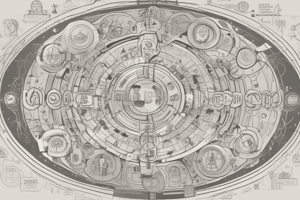Podcast
Questions and Answers
What is the definition of a leader?
What is the definition of a leader?
- Someone who challenges the status quo (correct)
- Someone who formulates detailed plans
- Someone who creates efficient organizational structures
- Someone who oversees day-to-day operations
What is motivation?
What is motivation?
- A measure of intensity or drive
- A measure of individual needs
- A process by which a person's efforts are directed towards attaining a goal (correct)
- A result of personal traits
What is the difference between leaders and managers according to the text?
What is the difference between leaders and managers according to the text?
- Leaders create efficient organizational structures, managers challenge the status quo
- Leaders inspire organizational members to achieve visions, managers create efficient organizational structures
- Leaders challenge the status quo and create visions of the future, managers oversee day-to-day operations (correct)
- Leaders formulate detailed plans, managers oversee day-to-day operations
According to Maslow's Hierarchy of Needs Theory, what must individuals satisfy before they can satisfy higher-order needs?
According to Maslow's Hierarchy of Needs Theory, what must individuals satisfy before they can satisfy higher-order needs?
What is required for optimal effectiveness according to the text?
What is required for optimal effectiveness according to the text?
According to Maslow's Hierarchy of Needs, which need is considered a higher-order (internal) need?
According to Maslow's Hierarchy of Needs, which need is considered a higher-order (internal) need?
Which theory assumes that workers can exercise self-direction, desire responsibility, and like to work?
Which theory assumes that workers can exercise self-direction, desire responsibility, and like to work?
What does 'transfer' mean in the context of communication?
What does 'transfer' mean in the context of communication?
What function of communication involves formal and informal communications that act to control individuals’ behaviors in organizations?
What function of communication involves formal and informal communications that act to control individuals’ behaviors in organizations?
In interpersonal communication, what constitutes nonverbal messages?
In interpersonal communication, what constitutes nonverbal messages?
Study Notes
Leadership and Management
- A leader is an individual who guides and influences others to achieve a common goal or vision
- Key difference: leaders focus on people, while managers focus on systems and processes
Motivation
- Motivation is the reason or stimulus that drives individuals to take action or achieve a goal
- According to Maslow's Hierarchy of Needs Theory:
- Basic physiological needs (e.g., food, water, shelter) must be satisfied before higher-order needs can be addressed
- Higher-order needs include esteem, social, and self-actualization
Organizational Effectiveness
- Optimal effectiveness requires a combination of individual and organizational factors, including motivation, leadership, and communication
Communication
- Transfer in communication refers to the process of conveying information from the sender to the receiver
- Control function of communication involves formal and informal communications that guide and regulate individuals' behaviors in organizations
Interpersonal Communication
- Nonverbal messages in interpersonal communication include facial expressions, body language, tone of voice, and other cues that convey meaning beyond spoken words
Studying That Suits You
Use AI to generate personalized quizzes and flashcards to suit your learning preferences.
Description
This quiz focuses on contrasting leadership and management, highlighting the differences in roles and responsibilities. It covers the influence of leaders, the creation of visions, and the formulation of detailed plans by managers.



